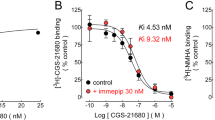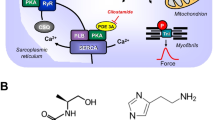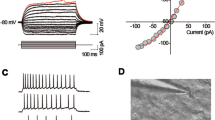Abstract
The present study was aimed at the identification of mechanisms following the activation of histamine H3 receptors.
Mouse brain cortex slices preincubated with 3H-noradrenaline were superfused and the (H3 receptor-mediated) effect of histamine on the electrically evoked tritium overflow was studied under a variety of conditions. The extent of inhibition produced by histamine was inversely related to the frequency of stimulation used to evoke tritium overflow and to the Ca2+ concentration in the superfusion medium. An activator (levcromakalim) and blocker (glibenclamide) of ATP-dependent K+ channels did not affect the electrically evoked tritium overflow and its inhibition by histamine. A blocker of voltage-sensitive K+ channels, tetraethylammonium (TEA), increased the evoked overflow and attenuated the inhibitory effect of histamine. TEA also reduced the inhibitory effect of noradrenaline and prostaglandin E2 on the evoked overflow. When the facilitatory effect of TEA on the evoked overflow was compensated for by reducing the Ca 2+ concentration in the superfusion medium, TEA did no longer attenuate the effect of histamine. Exposure of the slices to the SH group-alkylating agent N-ethylmaleimide increased the evoked overflow and attenuated the inhibitory effect of histamine; both effects were counteracted by the SH group-protecting agent dithiothreitol, which, by itself, did not affect the evoked overflow and its inhibition by histamine. Mouse brain cortex membranes were used to study the effect of the H3 receptor agonist R-(−)α-methylhistamine on the basal cAMP accumulation and on the accumulation stimulated by forskolin or noradrenaline. R-(−)-α-Methylhistamine did not affect basal cAMP accumulation but, at high concentrations, inhibited the forskolin- and noradrenaline-stimulated cAMP accumulation. S-(+)-α-Methylhistamine (which is 100 times less potent than R-(−)-α-methylhistamine at H3 receptors) was equipotent with the R-(−)-enantiomer in inhibiting the forskolin-stimulated CAMP accumulation.
The inhibition by R-(−)-α-methylhistamine was not affected by the H3 receptor antagonist clobenpropit but was counteracted by the α2-adrenoceptor antagonist rauwolscine.
The present results suggest that the histamine-induced inhibition of noradrenaline release depends on the availability of extracellular Ca2+ ions for stimulus-release coupling; in particular, a decrease in Ca 2+ influx into the varicosities may contribute to this inhibition. The H3 receptors (which may be coupled to a G protein) do not appear to be coupled to adenylate cyclase, to ATP-dependent K+ channels or to (TEA-sensitive) voltage-regulated K+ channels. α-Methylhistamine, in addition to its main action as a stereoselective H3 receptor agonist, proved to be weakly potent as an α2-adrenoceptor agonist.
Similar content being viewed by others
References
Allgaier C, Feuerstein TJ, Hertting G (1986) N-ethylmaleimide (NEM) diminishes α2-adrenoceptor mediated effects on noradrenaline release. Naunyn-Schmiedeberg's Arch Pharmacol 333:104–109
Allgaier C, Hertting G, Gottstein P (1992) Muscarine receptor-mediated regulation of electrically evoked acetylcholine release in hippocampus: effects of K+ channel blockers. Pharm Pharmacol Lett 2:191–194
Allgaier C, Repp H, Hertting G (1993) Effect of K+ channel blockers on the α2-adrenoceptor-coupled regulation of electrically evoked noradrenaline release in hippocampus. Naunyn-Schmiedeberg's Arch Pharmacol 347:14–20
Arrang JM, Garbarg M, Schwartz JC (1985) Amoregulation of histamine release in brain by presynaptic H3-receptors. Neuroscience 15:553–562
Arrang JM, Garbarg M, Lancelot JC, Lecomte JM, Pollard H, Robba M, Schunack W, Schwartz JC (1987) Highly potent and selective ligands for histamine H3-receptors. Nature 327:117–123
Arrang JM, Roy J, Morgat JL, Schunack W, Schwartz JC (1990) Histamine H3 receptor binding sites in rat brain membranes: modulations by guanine nucleotides and divalent cations. Eur J Pharmacol Mol Pharmacol Sect 188:219–227
Asano T, Ogasawara N (1986) Uncoupling of γ-aminobutyric acid B receptors from GTP-binding proteins by N-ethylmaleimide: effect of N-ethylmaleimide on purified GTP-binding proteins. Mol Pharmacol 29:244–249
Bradford MM (1976) A rapid and sensitive method for the quantitation of microgram quantities of protein utilizing the principle of protein-dye binding. Anal Biochem 72:248–254
Cherifi Y, Pigeon C, Le Romancer M, Bado A, Reyl-Desmars F, Lewin MJM (1992) Purification of a histamine H3 receptor negatively coupled to phosphoinositide turnover in the human gastric cell line HGT1. J Biol Chem 267:25315–25320
Cook NS (1988) The pharmacology of potassium channels and their therapeutic potential. Trends Pharmacol Sci 9:21–28
Fink K, Schlicker E, Göthert M (1994) N-Methyl-D-aspartate (NMDA)-stimulated noradrenaline (NA) release in rat brain cortex is modulated by presynaptic H3-receptors. Naunyn-Schmiedeberg's Arch Pharmacol 349:113–117
Garbarg M, Trung Tuong MD, Gros C, Schwartz JC (1989) Effects of histamine H3-receptor ligands on various biochemical indices of histaminergic neuron activity in rat brain. Eur J Pharmacol 164:1–11
Hertting G, Wurster S, Allgaier C (1990) Regulatory proteins in presynaptic function. Ann NY Acad Sci 604:289–304
Hill SJ (1990) Distribution, properties, and functional characteristics of three classes of histamine receptor. Pharmacol Rev 42:45–83
Hille B (1992) Potassium channels and chloride channels. In: Ionic channels of excitable membranes, 2nd edn. Sinauer, Sunderland, Mass., pp 115–139
Jakobs KH, Aktories K, Schultz G (1984) Mechanisms and components involved in adenylate cyclase inhibition by hormones. In: Greengard P et al (eds) Advances in cyclic nucleotide and protein phosphorylation research, vol 17. Raven Press, New York, pp 135–143
Kathmann M, Schlicker E, Detzner M, Timmerman H (1993) Nordimaprit, homodimaprit, clobenpropit and imetit: affinities for H3 binding sites and potencies in a functional H3 receptor model. Naunyn-Schmiedeberg's Arch Pharmacol 348:498–503
Leurs R, Timmerman H (1992) The histamine H3-receptor: A target for developing new drugs. Progr Drug Res 39:127–165
Lümmen G, Schlicker E (1991) Presynaptic histamine H3 receptors on the noradrenergic neurones in the rat brain: investigations into signal transduction and interaction with α2-autoreceptors. Naunyn-Schmiedeberg's Arch Pharmacol 343 [Supp1]:R94
Malinowska B, Schlicker E (1993) Identification of endothelial H1, vascular H2 and cardiac presynaptic H3 receptors in the pithed rat. Naunyn-Schmiedeberg's Arch Pharmacol 347:55–60
Malinowska B, Exner HJ, Godlewski G, Buczko W, Schlicker E (1994) EP3 receptor-mediated inhibition of the neurogenic vasopressor response in the pithed rat and of noradrenaline release in the mouse brain. Naunyn-Schmiedeberg's Arch Pharmacol 349[Suppl]:R78
Marley PD, Thomson KA, Jachno K, Johnston MJ (1991) Histamine-induced increases in cyclic AMP levels in bovine adrenal medullary cells. Br J Pharmacol 104:839–846
Nozaki M, Sperelakis N (1989) Pertussis toxin effects on transmitter release from perivascular nerve terminals. Am J Physiol 256: H455-H459
Panten U, Schwanstecher M, Schwanstecher C (1992) Pancreatic and extrapancreatic sulfonylurea receptors. Hormone Metab Res 24:549–554
Schlicker E, Behling A, Lümmen G, Göthert M (1992a) Histamine H3A receptor-mediated inhibition of noradrenaline release in the mouse brain cortex. Naunyn-Schmiedeberg's Arch Pharmacol 345:489–493
Schlicker E, Lümmen G, Behling A, Göthert M (1992b) Inhibition of noradrenaline release via NEM-sensitive H3 receptors in the mouse brain cortex: more marked effect than in the rat brain. Agents Actions (Special Conference Issue):C339–C342
Schlicker E, Behling A, Lümmen G, Malinowska B, Göthert M (1992 c) Mutual interaction of histamine H3-receptors and α2-adrenoceptors on noradrenergic terminals in mouse and rat brain cortex. Naunyn-Schmiedeberg's Arch Pharmacol 345:639–646
Schlicker E, Malinowska B, Kathmann M, Göthert M (1993) Modulation of neurotransmitter release via histamine H3 heteroreceptors. Fund Clin Pharmacol 7:336
Schlicker E, Malinowska B, Kathmann M, Göthert M (1994) Modulation of neurotransmitter release via histamine H3 heteroreceptors. Fund Clin Pharmacol 8:128–137
Schmid-Antomarchi H, Amoroso S, Fosset M, Lazdunski M (1990) K+ channel openers activate brain sulfonylurea-sensitive K+ channels and block neurosecretion. Proc Natl Acad Sci USA 87:3489–3492
Schömig E, Michael-Hepp J, Bonisch H (1988) Inhibition of neuronal uptake (uptake1) and desipramine binding by N-ethylmaleimide (NEM). Naunyn-Schmiedeberg's Arch Pharmacol 337:633–636
Schwartz JC, Arrang JM, Garbarg M, Pollard H, Ruat M (1991) Histaminergic transmission in the mammalian brain. Physiol Rev 71:1–51
Starke K (1977) Regulation of noradrenaline release by presynaptic receptor systems. Rev Physiol Biochem Pharmacol 77:1–124
Starke K, Göthert M, Kilbinger H (1989) Modulation of neurotransmitter release by presynaptic autoreceptors. Physiol Rev 69:864–989
Takata Y, Shimada F, Kato H (1992) Differential effects of diazoxide, cromakalim and pinacidil on adrenergic neurotransmission and 86Rb+ efflux in rat brain cortical slices. J Pharmacol Exp Ther 263:1293–1301
Van der Goot H, Schepers MJP, Sterk GJ, Timmerman H (1992) Isothiourea analogues of histamine as potent agonists or antagonists of the histamine H3-receptor. Eur J Med Chem 27:511–518
Van der Werf JF, Bast A, Bijloo GJ, Van der Wet A, Timmerman H (1987) HA autoreceptor assay with superfused slices of rat brain cortex and electrical stimulation. Eur J Pharmacol 138:199–206
West RE, Zweig A, Shih NY, Siegel MI, Egan RW, Clark MA (1990) Identification of two H3-histamine receptor subtypes. Mol Pharmacol 38:610–613
Yang OZ, Hatton GI (1991) H3-histamine receptors activate K+ channels to hyperpolarize magnocellular histaminergic neurons of rat posterior hypothalamus. Soc Neurosci Abstr 17:409
Author information
Authors and Affiliations
Additional information
Correspondence to: E. Schlicker at the above address
Rights and permissions
About this article
Cite this article
Schlicker, E., Kathmann, M., Detzner, M. et al. H3 receptor-mediated inhibition of noradrenaline release: an investigation into the involvement of Ca2+ and K+ ions, G protein and adenylate cyclase. Naunyn-Schmiedeberg's Arch Pharmacol 350, 34–41 (1994). https://doi.org/10.1007/BF00180008
Received:
Accepted:
Issue Date:
DOI: https://doi.org/10.1007/BF00180008




